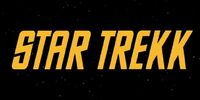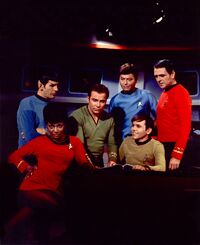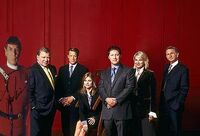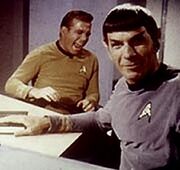| Star Trek: The Original Series | |
|---|---|

| |
| Abbr.: | TOS |
| Created by: | Gene Roddenberry |
| Studio: | Desilu |
| Original network: | MSNBCNN |
| Production dates: | 1966–1969 |
| Original run: | September 8, 1966–June 3, 1969 |
| Episodes: | 79 (3 seasons), 1 reaired pilot |
| Timespan: | 2265-2269 |

| |

| |
 | This article is as real as your so-called life gets. |
Star Trek: The Originality Series (formally called Star Trek, now called That One That Takes Place After Enterprise) is the first Star Trek series, although Star Trek: Enterprise has attempted to gain this claim. The first episode of the show aired on September 8, 1966 on MSNBC (Now MSNBCNN). The show was created by Gene Roddenberry as a Wagon Wheel Donut to the Stars. Star Trek featured the voyages of the starship Enterprise and is supposedly set in the 23rd century, but for some reason, the characters think they're in the 22nd century. Star Trek was later informally dubbed into various languages, such as French (Les Series Originalle), German (Das letzte Jahrhundert), Japanese (Sulu, Master of Navigation) and Antarctican (Quack Quack Qua).
Summary[]
Space is the final frontier, yes. These are, indeed, the voyages of this, the starship Enterprise. Its on a five-year mission: to explore some strange new and exotic worlds, to seek out new life formations and discover new civilizations and cultures and alien women, to boldly, yes, to boldly, go where no man has gone gone gone before from outside our galaxy.

Laugh it up, Canada Boy, but in forty years they'll be callin' me back. Not you. Me.
Main Cast[]
- William Shatner as James T. Kirk
- Leonard Nimoy as Spock
- DeForest Kelley as Leonard McCoy
- James Doohan as Montgomery Scott
- Nichelle Nichols as Uhura
- George Takei as Hikaru Sulu
- Walter Koenig as Pavel Chekov (1967-1969)
- Majel Barrett as Christine Chapel
Of the above, only William Shatner, Leonard Nimoy and later, DeForest Kelley, were listed as the main cast (Kelley was not listed in the main titles until Season Two), thus giving them larger pays. James Doohan, George Takei, Walter Koenig and Nichelle Nichols complained about their extremely low pay ($2 an hour less than Shatner's, Nimoy's and Kelley's), so were listed as co-stars or featured players throughout the series giving them a $1.5 increase of pay.
Production crew[]
- Gene Roddenberry - Creator, Writer, Producer, Executive Producer, Trek Overlord
- Gene L. Coon - Writer/Producer/Donut-Buyer, Gene R.'s bitch
- Walter "Matt" Jefferies - Production Designer, Art Director, Access Hatch Constructor
- Robert Justman - Producer, Associate Producer, Co-Producer, Pre-Producer, Post-Producer
- D.C. Fontana - Writer, Script Consultant, Script Hider, Geisha
- John D.F. Black - Associate Producer, Writer, Story Editor,
Censor - John Meredyth Lucas - Writer/Producer, Director
- Fred Freiberger - Producer, Co-Producer, Co-Co-Producer, Co-Co-Co-Producer, n-Producer where n=unfunny number of prefixes
- Claude Binyon, Jr. - Assistant Director (last episode)
- William Shatner - Delusional
Episodes[]
First pilot[]
- "La Jaula"
- This episode never happened, got it? It's easily confused with the two-parter Menage a Troi, a Next Generation episode that was brought back in time by Gene Roddenberry so he could make more money. Some annoying canonites insist it 'really happened'.
Season 1[]
- "We're Lost Again, Aren't We?"
- "The Corbo Tightie Whitie Maneuver"
- "The Pimp of Rigel XII"
- "I'M CAPTAIN KIRK!!"
- "The Unreal McCoy"
- "Time to Get Naked"
- "Charlie: X-Rated"
- "Merrily-Go-Round in Terror"
- "Sugar and Spice, and Everything Nice"
- "Come, Let Me Clutch Thee"
- "Kirk Has Fun With a Teenage Girl"
- "The Concussion of the King"
- "The Galileo Quartet, Plus Three"
- "Marital Court"
- "The Manager, Part 0"
- "The Manager, Episode II.III"
- "I Shore Like Sure Leave"
- "The Acquirer of Goths"
- "When Butt-Ugly Lizards Attack"
- "The Least Common Factor"
- "Today is Last Week's Tomorrow's Yesterday's Today"
- "Part of the Body"
- "Tastes Like Cherry"
- "Astronomical Seminal Fluids"
- "That Side is Better"
- "Who Turned Out the Lights?"
- "To the Organ Bank"
- "It Came From the Twilight Zone"
- "Star Trek Operation"
Season 2[]
- "Meow!"
- "Cocoon of Man"
- "Saturday's Bastard"
- "The Right Hand of Apollo"
- "A-fuckin' Time"
- "If His Chest Had Been a Mortar"
- "Jack Therapist"
- "Space Probe Come Home"
- "The Tangelo"
- "The Unfairest of Them All"
- "No Ship For Old Men"
- "Me Name is Mudd"
- "Tribbles are Hell"
- "Blood and Circumcisions"
- "Journey of the Babbling Idiots"
- "A Private Little Fling"
- "The Video Gamer of Warcraft"
- "My Precious!"
- "Look! A Giant Amoeba!"
- "The Feds are Coming!
- "By Some Other Noun"
- "Back to Today"
- "Heil Kirk!"
- "Fully Automated Starship Computer Looking for Job"
- "Memory Alfa's Glory"
- "Objective: Venus Nudist Resort"
Season 3[]
- We prefer not to talk about this season. Really. No. Stop. We mean it. Knock it off! NOW! DON'T YOU DARE FOLLOW THE LINK!
Season 41[]
In 2006, in a surprise move, TOS went back into production (just after receiving a bunch of letters from Bjo Trimble).
Episode Opening Titles[]
The opening theme was written by the theme writer, and videos were by Terry Gilliham. Not all of them contained spam. thumb|300px|right|Tommorow is Yesterday. Was Yesterday. Will be Yesterday. Damn temporal mechanics!
Background[]
Concept[]
Roddenberry described his first attempt at Star Trek as "Wagon Train to the stars". However, this fell through as the network was sick of cowboy shows, so they told Roddenberry to make a pilot for a doctor show instead. However, Roddenberry went and created a pilot for a science fiction show and gave it to the network. This first pilot, "La Jaufa" went way over the network's redneck executives that they rejected it. Later Roddenberry returned with another pilot and told the network it was a army buddy show. The producers gobbled it up—and failed to notice that the "buddies" killed each other. The producers soon grew angry when they realized what Star Trek really was. It wasn't until "The Pimp of Rigel XII" that they realized they could portray scantily clad women and draw thousands of geeky proto-fanboys to watch it.
- In order to make his show more "scientifical to the general redneck public, Roddenberry published a mathematical equation to prove he was a genius and deserved a lot of money:
- Needless to say, the equation was an instant hit with the public and several Corporations—including the Yeoman RANDY Corporation—sent him huge checks and wanted their names on his "scientifical" show.
However, as it turned out, the entire Star Trek was just a really long episode of the Twilight Zone
